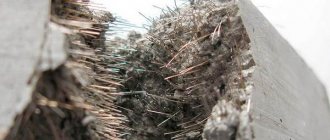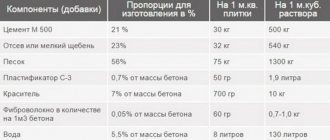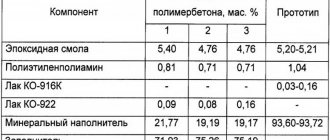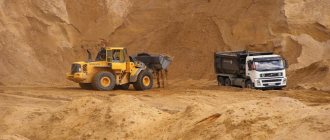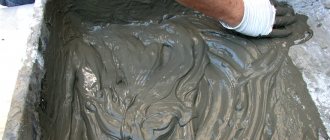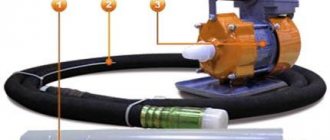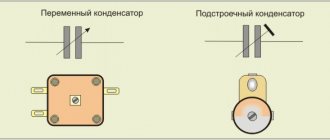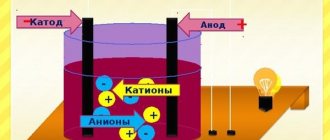About the material
Silicate concrete is a colorless substance. The binding element is limestone mixed with siliceous material (the grind should be fine). The materials enter into a chemical reaction with each other, which produces calcium hydrosilicate, which holds the monolith together with the filler. By similar processes, silicate materials distinguish themselves from other concretes.
As already mentioned, the properties of silicate substances are similar to cement ones. There are several significant differences:
- Water-repellent composition. The mixture is impregnated, carbonized, and coated with silicon compounds that reject moisture.
- Resistance to aggressive external factors.
- Larger amount of calcium oxide compounds (due to slag additives).
- The presence of artificial pores filled with gas, water, foam.
- The presence of aluminum powder and hydrogen peroxide in the composition (act as gas formers).
You should be aware of the possibility of corrosion. It depends on the density of the substance and operating conditions. The fittings do not corrode under adequate service conditions and minimal maintenance. Corrosion is ensured in the following cases:
- high room humidity;
- lack of anti-corrosion additives;
- variable climate conditions of the building.
ADVANTAGES OF SILICATE BLOCKS
The advantages of blocks include:
- resistance to cold cycles (designed for 50 – 100 cycles);
- excellent sound insulation characteristics;
- heat resistance;
- long operational period.
As part of the implementation of the state program “Affordable Housing”, the production of low-cost products from silicate material of non-autoclave and autoclave hardening has become a promising area. Sandy is a clay rock with good chemical activity, used for the production of silicate autoclaved concrete. In the process of autoclave processing of such material using an accelerated hardening option, coarse-crystalline phases of different compositions are obtained. They play the role of fillers for low-basic hydrosilicates, which are obtained by mixing sand, lime, and clay rocks.
When the binder hardens in the material, an artificial high-strength stone is formed. The siliceous component (crushed sand) affects the structure of the entire material. As the fineness of sand grains increases, the performance characteristics of the finished composition also increase:
- frost resistance;
- strength.
The siliceous component is natural or artificial pozzolan: fine quartz sand, blast furnace metallurgical slag, thermal power plant ash.
Important! Depending on the fineness of sand grinding, it contains different amounts of calcium oxide, which affects the quality of the resulting building material.
The result of the reaction between sand and lime occurring in an autoclave will be low-basic calcium hydrosilicates, which have a scaly or fine-needle microcrystalline structure, increasing the durability of products.
Silicate concrete. Receiving technologies. Development prospects. Properties
The properties, applications and production technology of silicate concrete are considered.
Currently, in Russia, within the framework of the national project “Affordable and comfortable housing for Russian citizens,” the direction of developing the production of inexpensive, high-quality products from silicate concrete of autoclaved and non-autoclaved hardening has become particularly relevant [1–14]. In a number of quarries, technogenic sand and clay raw materials are a component of overburden. It is sandy clay rock with high reactivity that is successfully used to produce autoclaved silicate concrete. When such a material is autoclaved under an accelerated hardening regime, coarse-crystalline phases of various compositions are formed. They play the role of a microfiller in the gel phase of low-basic hydrosilicates formed by the interaction of lime and rock-forming minerals of sandy clay rocks. [3–5].
Technologies for producing silicate concrete are one of the leading areas of technology development included in the “Priority directions for the development of science and technology and critical technologies at the federal level” and correspond to the “Main directions of the Russian Federation in the field of development of science and technology for the period up to 2010 and beyond.” , approved by the President of the Russian Federation in February 2002.
In the post-Soviet space, they are most actively working [8, 9, 11, 12, 14] to improve the technology of silicate concrete in Belarus and Ukraine. The shortage of cement has most significantly changed the course of development of this area of scientific and practical work in these countries.
The binder in silicate concrete is a calcareous-siliceous binder or a lime-sand-clay binder, which, after mixing with water, is capable of forming a high-strength artificial stone during steaming in an autoclave.
Finely ground sand, a siliceous component, in the composition of the binder has a great influence on the formation of the structure of silicate concrete.
The performance properties (strength, frost resistance, etc.) of silicate products increase with increasing dispersion of ground sand particles. Natural or artificial pozzolans are used as a silica component, such as ground quartz sand, tripoli, metallurgical blast furnace slag, and thermal power plant ash. The higher the fineness of sand grinding, the higher the relative content of CaO in the working mixture of silicate concrete. This pattern in the ratio of lime and sand (pozzolans) is maintained until the ratio at which all the lime can react with the silica component during autoclave processing in a given mode. As a result of the reaction, low-basic calcium hydrosilicates are formed, having a fine-needle or scaly microcrystalline structure of the CSH(B) type, and tobermorite. However, along with low-basic ones, coarse-crystalline highly basic calcium hydrosilicates of the C2SH(A) type can also be formed. The reaction occurs only at elevated temperatures and pressures.
For silicate products with a strength of up to 10–15 MPa, unground sand can be used in a mixture with lime 6–10% based on active CaO.
Products made from ground quicklime can be obtained with increased strength and frost resistance. For this purpose, the timing of lime hydration is regulated by introducing gypsum, surfactants, etc. It is advisable to use ground quicklime for products made from a plastic concrete mixture. In such freshly molded products, slaking of ground lime does not cause the formation of cracks, and the increase in volume contributes to greater compaction of the product. In addition, during the subsequent hydration of quicklime, the calcium oxide hydrate that appears in already molded products interacts more actively with silica than the calcium oxide hydrate previously formed in the slaked lime.
In heavily pressed products made from rigid mixtures, slaking of ground quicklime can lead to the formation of cracks. With an increase in the degree of compaction of products made from a lime-silica mixture, it is advisable to partially slak the lime by grinding it together with wet sand or pre-conditioning, as, for example, in the production of sand-lime brick.
The possibility of obtaining modified silicate materials without autoclave hardening [11] with increased thermal and waterproofing properties by modifying the structure due to mechanical activation of the lime-cement-silica mixture due to amorphization of the surface of crystalline quartz (specific surface above 4000 cm2/g) has been theoretically substantiated and experimentally confirmed. , as well as chemical activation due to the introduction of the mineral additive tripoli. Hardening modes for products with a given set of performance properties have been optimized.
A new, patent-licensed area of work is the production of silicate concrete and plaster compositions from mechanically activated lime [7].
Slaking of calcium, magnesium or dolomitic lime is carried out in the process of crushing, grinding and mechanical activation (lumpy lime - boiling lime - special hydrated lime with a residue <=2.5 on a 0.045 sieve). To facilitate the process of slaking lime using mechanical activation in a continuous flow, it can be mixed with quartz white sand.
During the activation of finely ground lime in vibrating centrifugal mills, only part of the total supplied energy is consumed to form a new surface; the rest of the energy is accumulated in the form of stressed structural defects of the lime. This accumulated energy subsequently has a significant impact on the speed of various technological processes and the formation of calcium hydrosilicates of increased basicity, as well as on the basic physical and mechanical properties of silicate products. The use of mechanically activated lime in combination with active mineral additives has become a new stage in the development of the production of products (non-autoclave hardening or reducing the cost of steaming them in an autoclave) from high-quality silicate concrete.
The manufacturing technology of silicate concrete products consists of the following main operations: sand extraction and separation of large fractions; extraction and roasting of limestone (if lime is produced at a silicate plant); lime crushing; preparation of lime-sand binder by dosing lime, sand and gypsum and grinding them in ball mills; preparation of silicate concrete mixture by mixing unground sand with finely ground lime-sand mixture and water in concrete mixers with forced mixing; molding products and curing them; hardening of molded products in autoclaves at temperatures of 174–200 °C and saturated steam pressure up to 0.8–1.5 MPa. To obtain dense silicate products, lime with a specific surface area of 4000–5000 cm2/g is used, and sand – 2000–2500 cm2/g and up to 4000 cm2/g.
The entire autoclave processing cycle is conventionally divided into five stages: (1) from the beginning of steam injection until the temperature in the autoclave reaches 100 ° C, (2) increasing the temperature of the medium and steam pressure to the designated minimum (the first and second stages in total - 2–6 hours ), (3) isothermal exposure at a maximum pressure of 9–13 kgf/cm2 and a temperature of 175–190 °C (4–8 hours), (4) reduction of pressure to atmospheric and temperature to 100 °C (2–3 hours ), (5) a period of gradual cooling of products from 100° to 18–20 °C either in an autoclave or after unloading them from the autoclave.
The quality of autoclaved silicate products depends not only on the composition and structure of the new formations, but also on the correct control of physical phenomena that arise at various stages of autoclave processing. During autoclave processing, in addition to the physicochemical processes that ensure the synthesis of calcium hydrosilicates, there are physical processes associated with temperature and humidity processes determined by the thermodynamic properties of water vapor and changes in the physical characteristics in the raw material mixture, and then in the resulting artificial silicate stone.
The raw material for producing silicate concrete is lime.
Construction air lump lime.
Quick-quenching construction lime is widely used for the production of lime-sand binder, which is used for the production of building materials, such as silicate bricks, products made of cellular silicate concrete, plaster mortars and concrete.
Lump lime is in wide demand in the construction industry and meets the requirements of GOST 9179-77. The content of active CaO + MgO is 70–79% (grade 3). The content of active MgO is up to 2%. Extinguishing time - up to 8 minutes.
Ground construction lime, GOST 9179-77
. High quality lime is ensured by stable technology and high-quality raw materials.
Ground construction lime is widely used to produce binding materials; it is used for the production of silicate products from cellular and dense silicate concrete, plaster and masonry mortars and concrete.
The content of active CaO + MgO is not less than 55% (grade 2). The content of active MgO is up to 2%.
In bags: the content of active CaO + MgO is not less than 40%; content of active MgO - up to 2%; degree of hydration - 80%.
In the production of colored silicate products for coloring calcareous-siliceous binders in the process of mixing them with sand, it is advisable to use tinting pastes rather than powdered pigments, as is done in many industries. It is not difficult to make tinting pastes for your own use in paint grinders of the “CO” type. Pastes are a thick mass of pigments ground into an aqueous solution of dispersants and stabilizers. In case of thickening during storage, the tinting paste is diluted with water to the required consistency. After dilution with water, it is necessary to apply the tinting paste within 1 hour to avoid precipitation of the pigment. Coloring pastes should be stored in a heated room at a temperature not lower than 0 °C.
Coloring pastes are introduced into the silicate mass or plaster solution after complete mixing of all components in rod or other mixers, then the mass is mixed until a uniform color is obtained.
The dosage of tinting paste is determined by the required color shade of the finished product after hardening of the silicate concrete. The recommended dosage, which refers to the percentage of pigment to the mass of the dry lime-silica mixture (filler sand is not considered) when making products by semi-dry vibropressing, is as follows: red color - 1.5; yellow - 2.2; black - 0.7; brown - 1.5; green color - 0.2; blue - 0.2.
Another possible method of coloring silicate concrete mass is to use pre-colored lime.
Coloring and slaking of lime is carried out in vibrating centrifugal mills using any alkali-resistant dyes in the process of mechanical activation. The introduction of titanium dioxide in an amount of up to 5% by weight of lime increases the refractive index of the finished product by 10%. The use of such a special hydrated colored mechanically activated white lime as part of the painting plaster made it possible to obtain highly artistic properties of finishing work on the facades of churches.
To obtain colored lime of other colors, colored alkali-resistant pigments should be introduced to replace part of the prescription titanium dioxide. The presence of titanium dioxide makes it possible to obtain opaque thin layers of artificial stone, otherwise the plastered wall can be seen through, restoration of lost layers of plaster and other defects of the facade are visible.
Slaked mechanically activated powdered colored lime complies with the color standard agreed with the customer and is ready for immediate use. The use of slaked mechanically activated colored lime can significantly expand the volume and range of architectural finishing work on the facades and interiors of buildings using dry building mixtures [6, 7], and improve the quality of the external appearance of urban and rural buildings.
Slaked mechanically activated colored lime must be used in accordance with building codes and regulations.
The development has undergone industrial testing in the city of Kolomna, Moscow region, at the production facilities of JSC Shchurovsky Cement and is ready for implementation.
Silicate concretes
classified by volumetric mass.
Heavy silicate concrete: dense aggregates - crushed stone, sand or sand-gravel mixture.
Light silicate concrete: porous aggregates - expanded clay, expanded perlite, vermiculite, agloporite, etc.
Cellular silicate concrete: fillers - air bubbles, evenly distributed throughout the volume of the product.
Technical requirements for silicate concrete of a dense structure for prefabricated concrete and reinforced concrete products and prefabricated structures are given in the national standard GOST 25214-82 “Dense silicate concrete. Technical conditions". The requirements of this standard are mandatory for use if this GOST is specified in the contract for the production or supply of silicate concrete and products made from it in the “Technical Characteristics of Products” section.
Dense silicate concrete is used to make load-bearing structures for residential, industrial and rural construction: panels of internal walls and ceilings, flights of stairs and landings, beams, purlins and columns, cornice slabs, etc. ( Fig. 1
).
Recently, heavy silicate concretes have been used for the manufacture of such high-strength products as pressed asbestos-free slate, stressed-reinforced silicate concrete railway sleepers, reinforced silicate concrete tubing for panel tunneling of metro tunnels and for mine construction (strength 60 MPa or more).
Corrosion of reinforcement in silicate concrete depends on the density of the concrete and the service conditions of the structures; During normal operation of structures, reinforcement in dense silicate concrete is not subject to corrosion. During wet and variable operating conditions in structures made of dense silicate concrete, the reinforcement must be protected with anti-corrosion coatings, as is done at KZHBI No. 211 in Sertolovo, Leningrad Region ( Fig. 2
).
For the manufacture of autoclaved silicate products, lime consumption is 175–250 kg per 1 m3 of product. Large-sized products are molded on vibrating platforms, sometimes with a weight or with a vibration load. Molded silicate products are steamed in autoclaves with a diameter of 2.6 and 3.6 m.
Large-sized vibration-compacted silicate products have a compressive strength of 15–40 MPa, a density of 1800–2100 kg/m3, and frost resistance of 50 cycles or more. With power vibration rolling, silicate products have a strength of up to 60 MPa and a density of up to 2300 kg/m3. Dense silicate concrete products are used for the construction of residential, industrial and public buildings; It is not recommended to use them for foundations and other structures operating in high humidity conditions.
The properties of products made from silicate concrete are similar to those of products made from cement concrete. Silicate concretes according to GOST 25214 are characterized by the following indicators and properties.
Compressive strength - B5 (M75), B7.5 (M100), B10 (M150), B12.5 (M150), B15 (M200), B20 (M250), B25 (M350), B30 (M400), B35 (M450), B40 (M500), B45 (M600), B50 (M700), B55 (M700), B60 (M800).
Based on frost resistance, water resistance and average density (volumetric mass), the following grades are established:
frost resistance: Mrz 35, Mrz 50, Mrz 75, Mrz 100, Mrz 150, Mrz 200, Mrz 300, Mrz 400, Mrz 500, Mrz 600;
water resistance: B2, B4, B6, B8, B10;
by average density (volumetric mass): Pl1000, Pl1100, Pl1200, Pl1300, Pl1400, Pl1500, Pl1600, Pl1700, Pl1800, Pl1900, Pl2000, Pl2100, Pl2200, Pl2300, Pl2400.
Axial tensile strength - from R 10 to R 40.
Tensile strength during bending - from Ri 25 to Ri 70.
Many prefabricated products used in residential, civil, industrial and rural construction, including specialized products of complex shapes, can be made from silicate concrete. It is most effective to manufacture hollow products from silicate concrete, since voids improve the heating and cooling conditions of products, reduce the weight of products and reduce material consumption.
The design of products made of silicate concrete is carried out according to SNiP 2.03.01-84 and SNiP 2.03.02-86 “Concrete and reinforced concrete structures made of dense silicate concrete”. These norms and rules apply to the design of concrete and reinforced concrete structures made of dense silicate concrete on dense aggregates in accordance with GOST 25214-82 and intended for operation under conditions of systematic exposure to temperatures not higher than 50 ° and not lower than 70 ° C.
The properties of sand-lime brick are regulated by GOST 379-79 “Silicate bricks and stones. Technical conditions". Main characteristics of sand-lime brick:
strength grade - M 125, M150;
frost resistance grade - F15, F25, F35;
thermal conductivity - 0.38–0.70 W/m2K.
Sand-lime brick is an autoclaved material, a type of silicate concrete with fine aggregate, having the shape and dimensions of a brick. It consists of approximately 90% lime, 10% sand and a small proportion of additives. By adding a certain amount of pigments, you can get sand-lime brick of any color. The standard sizes of sand-lime bricks (single, one-and-a-half, double) are similar to the standard sizes of ceramic bricks. The requirements for the quality, geometry and appearance of sand-lime brick are similar to those for ceramic bricks.
Silicate stones with crushed texture
(
Fig. 3
) are used for finishing building facades and for decorative elements of fencing of individual garden houses and cottages. Complies with STB 1008-95 standard. The enterprises produce bricks and stones in a wide range of colors, as well as with a crushed surface. Dimensions (mm): 250 x 120 x 44; 250 x 60 x 88; 250 x 90 x 88; F25, F35, F50.
Silicate stones with crushed texture of a different shape
(
Fig. 4
) is another type of decorative stones. They are used for finishing building facades and for decorative elements of fencing of individual garden houses and cottages. Complies with STB 1008-95 standard. The enterprises produce bricks and stones in a wide range of colors, as well as with a crushed surface.
Silicate concrete on porous aggregates
- a new type of lightweight concrete. It hardens in autoclaves. The binders for these concretes are the same as for dense silicate concrete, and the fillers are porous aggregates: expanded clay, expanded perlite, agloporite, slag pumice and other porous materials in the form of gravel and crushed stone. Currently, the industry offers a wide range of large-sized products made of silicate concrete, such as large wall blocks of internal load-bearing walls, floor panels and load-bearing partitions, steps, slabs, beams. Bending elements are reinforced with rods and meshes.
Nomenclature of wall materials made of cellular concrete.
In many of its characteristics, cellular concrete is significantly superior to traditional building materials; it has diffusion characteristics, thanks to which constant air humidity is maintained in the living room, and therefore the houses will never be damp, even in the fall. Cellular concrete is a fireproof material that reliably absorbs sound.
Small wall blocks made of cellular concrete
(
Fig. 5
) are used for laying partitions inside residential buildings and outbuildings with a relative air humidity of no more than 75%. Dimensions (mm): 588 x 150 (200, 400) x 288; 500 x 200 (300, 400) x 288; 588 x 200 x 250 (400); D500; M25; F35. Thermal conductivity - 0.125 W/m2K at W = 0%; D600; M35; F35. Thermal conductivity - 0.145 W/m2K.
Cellular concrete blocks for building partitions
(
Fig. 6
) are used for laying partitions inside residential buildings and outbuildings with a relative indoor air humidity of no more than 75%. Corresponds to TU 21-00010257-380-92. Dimensions (mm): 588 x 100 (120, 150) x 288; D700; M35, F35. Thermal conductivity - 0.182 W/m2K at W = 0%.
Thermal insulation slabs made of cellular concrete ( Fig. 7
) are intended for insulation of building structures and thermal insulation of industrial equipment at temperatures of the insulated surface up to 400 °C. Standard - STB 1034-96. Dimensions (mm): 588 x 100 x 288 (576); D350, D400. Thermal conductivity - 0.185 W/m2K at W = 0%. Strength grade (MPa) - 10.
So, the strength of silicate concrete in compression, bending and tension, its deformation properties, and adhesion to reinforcement provide the same load-bearing capacity of structures made of silicate and cement concrete with the same dimensions and degree of reinforcement. Therefore, silicate concrete can be used for reinforced and prestressed structures, which puts it on par with cement concrete.
This area of work has developed due to the rise in cost of high-quality, fast-hardening cements and energy resources for heat treatment in the manufacture of reinforced concrete structures.
Literature:
1. Avakumov E. G. Mechanical methods of activation of chemical processes. - Novosibirsk: Science, 1986.
2. Boynton R.S. Chemistry and technology of lime. - M.: Stroyizdat, 1972.
3. Volodchenko A. N., Zhukov R. V., Lesovik V. S., Doroganov E. A. Optimization of the properties of silicate materials based on lime-sand-clay binder // Construction Materials. - 2007. - No. 4. - P. 66–68.
4. Volodchenko A. N., Zhukov R. V., Fomenko Yu. V., Alfimov S. I. Silicate concrete on non-traditional raw materials // Concrete and reinforced concrete. - 2006. - No. 6. - P. 16–19.
5. Zhukov R.V. Autoclave building materials using associated rocks from the Arkhangelsk diamondiferous province: Abstract of the dissertation. — Belgorod: BSTU im. V. G. Shukhova, 2007.
6. Kuzmina V.P. State and prospects for the development of the Russian market of dry building mixtures // 5th International Construction Exhibition September 12–15, 2001 “Batimat” St. Petersburg.
7. Kuzmina V.P. Application of building mixtures in finishing cottage facades // Popular concrete science. 2005. - No. 5 (7). — pp. 128–135.
8. Lutskin E. S. Possibilities of using experimental-statistical modeling for correlation analysis between the properties and parameters of the structure of silicate materials // Collection of the IOC-43 seminar. - Odessa.
9. Oleinik O. M. Slag puddles and cemented concrete with vikoristan silicate suspensions: Abstract of the dissertation. — Simferopol: Krim. acad. environmental protection that resort. Budva, 2002.
10. Ratinov V. B., Rosenberg T. I. Additives to concrete. - M.: Stroyizdat, 1989.
11. Sadovsky G. P., Gara A. A., Tkachenko G. G. Non-autoclave silicate concrete // Collection of the IOC-43 seminar. - Odessa.
12. Sidorova N. V. Modified silicate materials of non-autoclave hardening. Structure, power: Abstract of the dissertation. — Odessa: Odes. holding acad. bud-va ta arhit, 2004.
13. Technology of binders / Ed. prof. V. N. Jung. - M: Stroyizdat, 1947. - P. 71.
14. Shinkevich E. S., Politkin S. I., Bondarenko G. G. Computational experiment in analyzing the influence of compositions and hardening modes on the structure and properties of silicate materials of non-autoclave hardening // Collection of seminar MOK-43. — Odessa, Nikolaev.
| Article provided by the magazine “Popular Concrete Science” The magazine "Popular Concrete Science" - always fresh and professional information about the production and use of concrete and other building materials, additives, equipment and much more. The publication is published with the support of the Scientific and Technical Society of Builders of St. Petersburg. Distributed in Russia, the CIS, and abroad. The magazine is intended for a wide range of readers - builders, technologists, designers. [email protected] Quick subscription to the magazine, 541-91-46 |
Properties of silicate concrete
The main properties of silicate concrete are represented by the following indicators:
- Water absorption of silicate products, depending on the method of compacting the concrete mixture, is 10–18%.
- The frost resistance of high-strength silicate concrete reaches 100 cycles or more.
- High corrosion resistance - these parameters differ slightly from those of cement concrete.
- Heat resistance.
- Resistance to temperature and atmospheric influences.
- Low cost of production of finished products.
- Durability (up to 70 years).
Peculiarities
Silicate concrete combines the best quality characteristics of the substances that make up its composition. These include:
frost resistance (up to 100 cycles); heat resistance; resistance to temperature changes; low cost; strength/stability; long period of operation (over 70 years).
Silicate concrete is used as a budget material for the construction of residential buildings. Government programs consider this industry promising and invest money in the use of silicate compounds. Please note that after the mixture hardens, an artificial stone is formed inside (it is very durable). Such a silicon element has a huge impact on the structure of the substance. The stone imparts frost-resistant, durable characteristics to the mixture and endows the material with them.
Important: the quality of the material depends on the level of calcium oxide. Its level depends on the degree of sand grinding. Sand combines with lime, forms calcium oxide, strengthens it, and gives the mixture special functions.
Return to contents
Currently reading: Expanded clay concrete blocks
Materials for the production of silicate concrete
The main binder component in silicate concrete is finely ground lime or fluffed lime, which, in combination with aggregates, constitutes the main raw material for the production of silicate concrete. After adding water and subsequent heat treatment in autoclaves, the silicate concrete mixture turns into a durable concrete product.
Lime used for the production of silicate mixtures must meet the following properties:
- average hydration rate;
- moderate exothermic effect;
- the entire fraction must be equally fired;
- MgO less than 5%;
- Lime slaking time: no more than 20 minutes.
Underburning of the lime mass leads to increased consumption of material. Overburning reduces the hydration time of lime, which leads to swelling, cracks on the surface of products, etc.
Lime
Lime used for the production of silicate concrete is usually used in the form of finely ground lime mixtures of the following composition:
- calcareous-siliceous - a combination of lime and quartz sand;
- lime-slag (lime and blast furnace slag);
- lime-ash - fuel oil shale or coal ash and lime;
- lime-expanded clay and other similar components obtained from industrial waste of porous aggregates;
- lime-belite binders obtained by low-temperature firing of a lime-siliceous dry mixture and quartz sand.
The following materials are used as siliceous fillers:
- quartz ground sand;
- metallurgical (blast furnace) slag;
- thermal power plant ash.
Most often, quartz sands of medium and fine fractions are used as fillers, which in their composition should look like this:
- 80% or more silica;
- less than 10% clay inclusions;
- 0.5% or less mica impurities.
Large inclusions of clay in the structure of quartz sand reduce the frost resistance and strength of silicate concrete.
Quartz sand
Finely ground quartz sand has a significant influence on the formation of high performance properties of silicate concrete. Thus, with increasing dispersion of sand particles, the frost resistance, strength and other characteristics of silicate materials increase.
When choosing components for the production of silicate concrete, you need to know the following:
- Binder consumption increases in proportion to the increase in concrete strength.
- A decrease in the consumption of binders in the silicate mixture is observed with an increase in the dispersion of fine quartz sand, and increases with an increase in the molding humidity of the silicate concrete solution.
- The dispersion of ground quartz sand should be 2.5 times lower than the dispersity of ground lime.
Products made from silicate concrete
Today, the following types of silicate products are produced from silicate-concrete mixtures:
- Large prefabricated reinforced concrete structures - floor slabs, blocks, silicate panels for facade walls.
- From small-piece products - ordinary, facing bricks, silicate stones (blocks) and gas silicate blocks for internal and external walls of residential and industrial buildings.
The most popular in individual construction are rightfully sand-lime bricks and silicate concrete products made from porous concrete, which are called gas silicate blocks.
Silicate wall material - brick
Type and structure of hollow sand-lime brick
Sand-lime brick is a wall material obtained from a mixture of slaked lime and quartz sand by pressing, followed by hardening in an autoclave under high temperatures and high water vapor pressure (see video in this article). The technology for manufacturing sand-lime bricks consists of the following technological processes:
- grinding of binder components (quartz sand and lime);
- dosing of components (lime - 15–25%; quartz sand - 75–85);
- mixing the components with the addition of water, as a result of which the lime is slaked and the components of the mixture are distributed;
- pressing products under high pressure (30–40 MPa);
- laying products on a trolley;
- autoclave heat treatment.
The consumption of binder components depends on the given density of the product. Mixing of components takes place in a twin-shaft mixer. Averaging of the mixture composition and slaking of lime are carried out in continuous or batch units.
Brick making press
Brick pressing is carried out using a revolving press. This is a carousel-type machine, equipped with an area for filling the mold with silicate solution, a pressing and pressing area, as well as an area for removing raw materials. The optimal moisture content of the molding sand is 5–7%.
Then the silicate products, laid on a trolley, are sent to an autoclave for drying and hardening.
The temperature in the autoclave should not be lower than 175°C, the optimal steam pressure is 0.8 MPa. The autoclave heat treatment time for medium-density sand-lime brick should be 8–12 hours.
Sand-lime bricks and stones can be of the following types:
- single brick, solid or hollow (250x120x65);
- thickened hollow brick (250x120x88);
- hollow silicate stones (250x120x138).
The color of ordinary sand-lime brick is milky white. Facing bricks can also be colored, painted with chemically resistant pigments in various decorative colors.
Types of colored silicate bricks assortment
For ordinary silicate bricks and silicate stones, the following strength grades are established: 75, 100, 125, 150, 175, 200, 250, 300; frost resistance grades - F15, F25, F35, F50.
The strength grade for silicate facing bricks should not be lower than 125, and the frost resistance grade should be F35 or more. Water absorption of silicate products should be no more than 6%.
Types and properties of sand-lime brick
Small-piece silicate products are used along with ceramic bricks for laying walls of the above-ground part of residential buildings and structures. Due to the insufficient moisture resistance of the material, it is prohibited to use it for constructing building foundations, even with a waterproofing layer.
It is not allowed to use silicate masonry materials for the construction of buildings with wet operating conditions (laundries, baths, etc.), as well as to use silicate products for laying stoves, etc.
In addition to lime-sand products, lime-ash and lime-slag bricks are also produced. In these brands, instead of sand, thermal power plant ash or blast furnace slag is used. The properties of these grades are similar to those of lime-sand silicate bricks.
Lime-ash and lime-slag silicate products
These wall materials are a type of silicate brick in which quartz sand is replaced by porous metallurgical slag (lime-slag) or fuel ash (lime-ash).
Blast furnace slag
The production of lime-slag sand-lime brick requires 88–97% blast furnace slag and 3–12% slaked lime, and the production of lime-ash material requires 75–80% fuel ash and 20–25% slaked lime.
Ash and slag are cheap silicate raw materials obtained by burning brown or hard coal in boiler houses of thermal power plants, etc. During the combustion of crushed fuel, large ash remains in the firebox, and small particles, along with flue gases, go into the chimney in which ash collectors are installed. The ash obtained in this way is sent to a dump, and then used in the production of silicate materials.
Fuel fly ash
Fuel ashes and slags have a low CaO content (<5%), and therefore, when combined with water, they harden poorly. But with the introduction of lime, they are activated, and subsequent heat treatment in an autoclave makes it possible to obtain high-strength materials.
The use of metallurgical slags and fuel ashes is economically beneficial, since the cost of finished silicate products is significantly reduced.
Lime-slag brick
The production of lime-ash and lime-slag bricks is comparable to the production of sand-lime bricks, but the characteristics are somewhat different from those of silicate sand products:
- brick size - 250x120x140;
- material density 1400–1600 kg/m3;
- thermal conductivity of products 0.6 W/(m*K);
- compressive strength (grades) - 75, 50 and 25;
- frost resistance is within the same limits as that of ordinary sand-lime brick.
Lime-ash brick
Lime-ash and lime-slag bricks are used to construct the walls of low-rise buildings.
Varieties
Silicate materials are classified as follows:
- special;
- structural.
Within these two types they are divided into:
- concrete, the tensile strength of which varies from 7.5 to 70 kg/m3;
- materials with average silicate density: 1000-2400 kg/m3;
- substances that are at the silicate strength level in the range from 1 to 4 kg/m3;
- waterproof materials.
The properties of the above substances vary depending on the type, composition, and purpose. The only unifying feature is that the properties are similar to the cement composition, regardless of the type of concrete.
Types of silicate concrete structures
Silicate concrete can be special and structural. Within these types, there are three main types of material: dense, heavy, light, cellular.
Dense heavy concrete
This type of silicate concrete is produced with siliceous fillers, depending on which the material can be fine/coarse-grained. Fine-grained mixtures are more popular; small fraction quartz sands are chosen to create them. The density of concrete is 1800-2200 kg/s3.
The main advantages of this type of silicate concrete are its uniform structure at low cost. The strength of the material depends on the percentage of fine sand. Heavy concrete of this type is in demand in the production of columns, floor panels, landings and flights, and in the creation of railway sleepers with reinforcement.
Lungs
Light silicate concretes are produced with the addition of porous fillers - perlite, expanded clay, pumice, which are in the form of gravel or crushed stone.
Types of light silicate concrete by density:
- Thermal insulation - with a density of up to 500 kg/m3, they are used as insulation, guarantee the creation of an optimal microclimate in the room, retain heat well and remove excess moisture from the interior space of the room.
- Structural and thermal insulation - the density of concrete is in the range from 500 to 1400 kg/m3, the material is suitable for creating external structural elements of an enclosing type.
- Structural - with a density of 1400 to 1800 kg/m3, these concretes are used in the production of reinforced concrete structures.
Cellular lungs
These concretes can also be of several types depending on the composition and production method. There are foam silicate and gas silicate concretes. Penosilicate is produced from a finely ground lime-silica mixture, which is mixed with a special foam, and then the material is processed in an autoclave. Gas silicate is made with the addition of aluminum powder to the lime-silica mixture. The material is more common in modern construction.
Manufacturing technology
Such concrete does not require a complex manufacturing plan. The main binders that are used are:
- lime/silica (from fine quartz sand, lime);
- slag (lime, metallurgical/fuel/phosphorus slag);
- lime/ash (fuel ash, crushed lime);
- lime/belite (sand, belite slag, lime, silica).
As mentioned above, difficult to obtain materials will not be required. Prepare the following materials to create concrete:
- astringent (one of the above);
- aggregate;
- water;
- special additives (depending on the type, purpose).
Mix the materials one by one, observing the proportions specified in the instructions for the materials. Such concrete maintains an optimal microclimate, which absorbs excess moisture if necessary. Silicate concrete has an inherent heat storage function.

